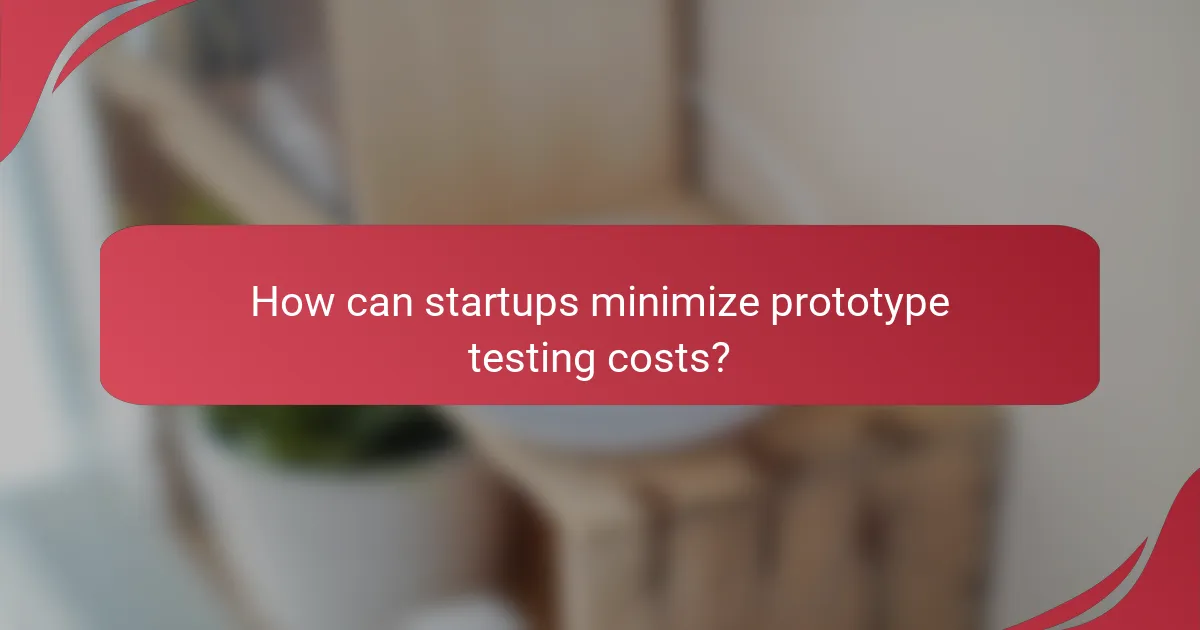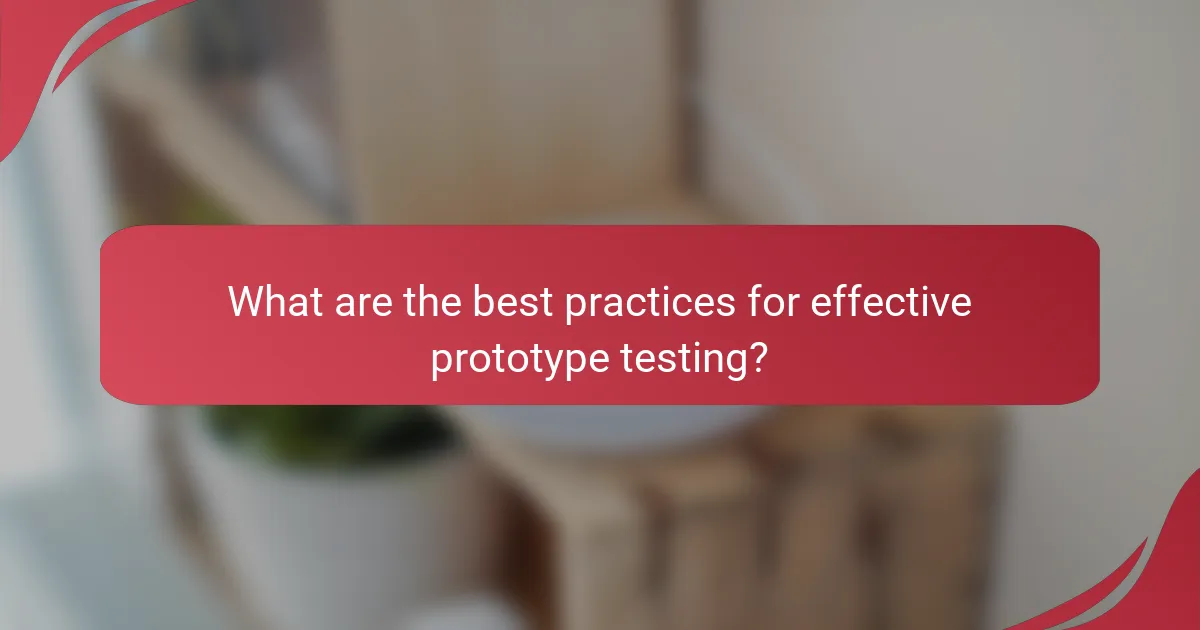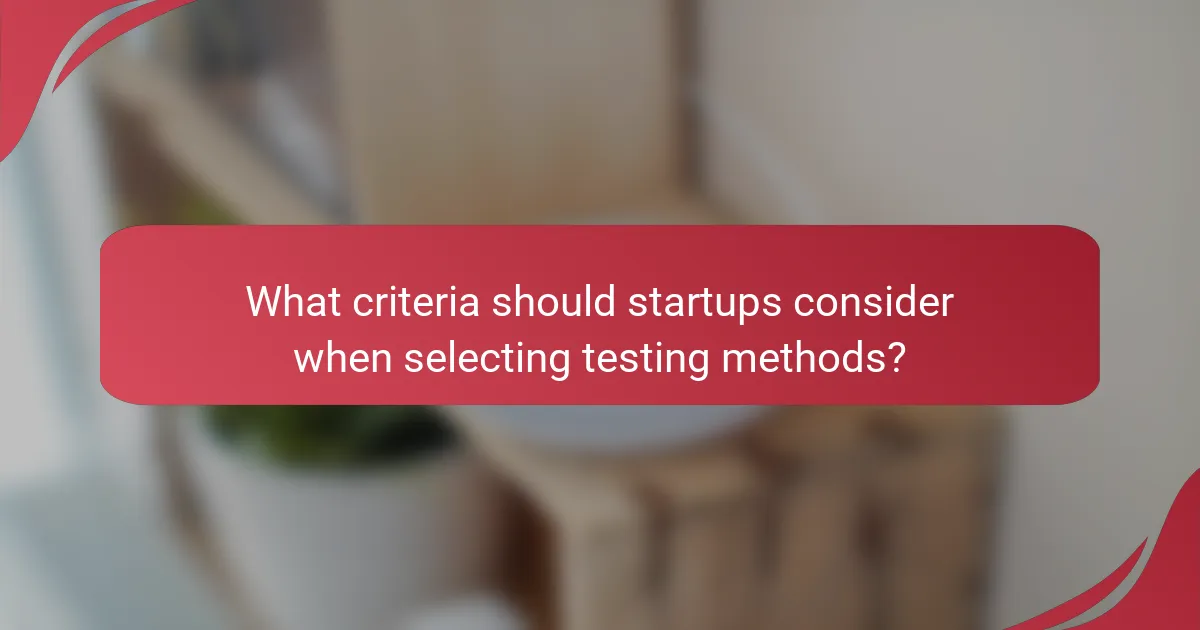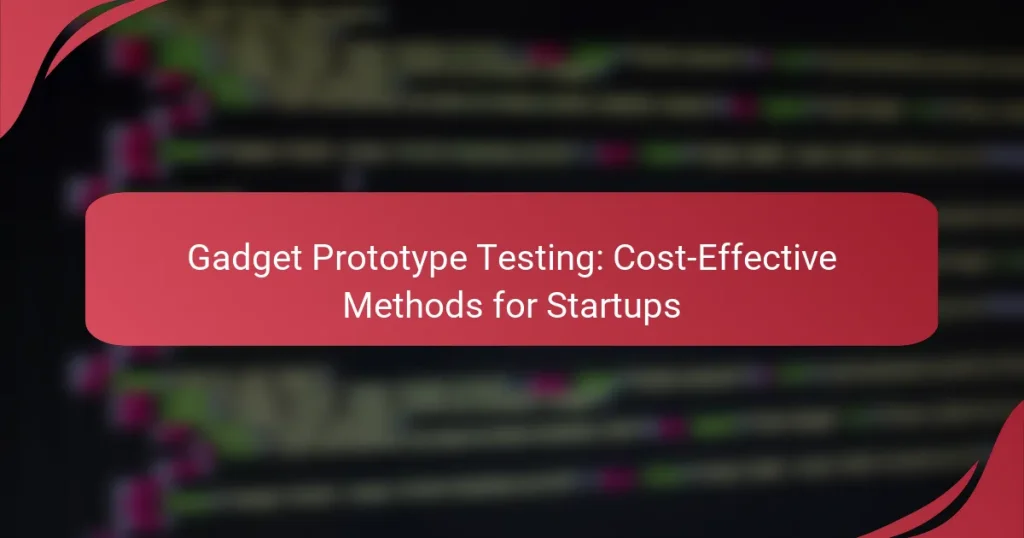For startups looking to test gadget prototypes without breaking the bank, cost-effective methods are essential. By leveraging technologies such as 3D printing, crowdsourced testing, and virtual simulations, startups can gather valuable feedback while minimizing expenses. Implementing flexible testing strategies and utilizing community resources further enhances collaboration and efficiency in the development process.

What are cost-effective methods for gadget prototype testing in startups?
Cost-effective methods for gadget prototype testing in startups include leveraging technologies and platforms that minimize expenses while maximizing feedback and insights. Startups can utilize 3D printing, crowdsourced testing, virtual simulations, low-cost user feedback sessions, and open-source frameworks to efficiently validate their prototypes.
3D printing for rapid prototyping
3D printing allows startups to create physical prototypes quickly and at a lower cost compared to traditional manufacturing methods. This technology enables rapid iterations, so designers can test and refine their concepts based on real-world feedback. Consider using materials like PLA or ABS, which are affordable and widely available.
Startups should focus on designing prototypes that are easy to print and modify. Utilizing online resources for 3D models can save time and reduce costs. Additionally, local makerspaces often provide access to 3D printers and expertise, further lowering expenses.
Crowdsourced testing platforms
Crowdsourced testing platforms connect startups with a diverse group of testers who provide feedback on prototypes. These platforms can be a cost-effective way to gather insights from potential users without the need for extensive in-house testing. Services like UserTesting or Testbirds offer flexible pricing models based on the number of testers and feedback required.
When using these platforms, clearly define the target audience and the specific feedback needed. This ensures that the insights gathered are relevant and actionable. Startups should also consider incentivizing testers to increase participation and engagement.
Virtual simulation tools
Virtual simulation tools allow startups to test their gadgets in a digital environment before physical prototypes are created. Software like SolidWorks or Autodesk Fusion 360 can simulate performance and identify potential issues early in the design process. This can save both time and resources by reducing the number of physical prototypes needed.
Startups should focus on integrating simulations that reflect real-world conditions as closely as possible. This includes considering factors like user interaction and environmental influences. Regularly updating simulation parameters based on user feedback can enhance accuracy and reliability.
Low-cost user feedback sessions
Conducting low-cost user feedback sessions can provide valuable insights into how real users interact with a prototype. Startups can organize informal sessions in community spaces or online to gather opinions without significant financial investment. Utilizing tools like Zoom or Google Meet can facilitate remote feedback collection.
To maximize the effectiveness of these sessions, prepare specific questions and scenarios for users to evaluate. Recording sessions can help capture insights for later analysis. Startups should aim to engage a diverse group of participants to ensure a wide range of perspectives.
Open-source testing frameworks
Open-source testing frameworks offer startups access to a variety of tools and resources without the associated costs of proprietary software. Platforms like Selenium or JUnit provide robust testing capabilities that can be customized to fit specific needs. This flexibility allows startups to adapt their testing processes as their prototypes evolve.
Startups should invest time in learning how to effectively use these frameworks, as the initial learning curve can be steep. Engaging with online communities can provide support and additional resources. Regularly updating and maintaining the testing framework is crucial to ensure it remains effective as the prototype develops.

How can startups minimize prototype testing costs?
Startups can minimize prototype testing costs by utilizing community resources, adopting digital tools, and implementing flexible testing strategies. These approaches not only reduce expenses but also enhance collaboration and efficiency in the development process.
Utilizing local maker spaces
Local maker spaces provide access to tools, equipment, and expertise that can significantly lower prototype testing costs. By joining a maker space, startups can use advanced machinery like 3D printers and CNC machines without the hefty investment of purchasing them outright.
Many maker spaces offer membership plans that are affordable, often ranging from monthly fees to pay-per-use options. This allows startups to prototype and test their designs in a collaborative environment, gaining valuable feedback from other members.
Leveraging online collaboration tools
Online collaboration tools streamline communication and project management, reducing the time and costs associated with prototype testing. Platforms like Trello, Slack, or Asana help teams coordinate tasks, share updates, and gather feedback efficiently.
Using these tools can also facilitate remote testing, allowing startups to gather user input from a broader audience without geographical constraints. This approach can save costs on travel and logistics while providing diverse insights into product performance.
Implementing agile testing methodologies
Agile testing methodologies focus on iterative development and rapid prototyping, which can significantly cut costs. By breaking down the testing process into smaller, manageable cycles, startups can quickly identify issues and make necessary adjustments without extensive rework.
Startups should prioritize creating minimum viable products (MVPs) that allow for early user testing and feedback. This approach not only saves resources but also ensures that the final product aligns closely with market needs, reducing the risk of costly revisions later on.

What are the best practices for effective prototype testing?
Effective prototype testing involves a structured approach that prioritizes clear objectives, user engagement, and iterative improvements. Startups can enhance their testing processes by focusing on these key practices to ensure their prototypes meet user needs and market demands.
Defining clear testing objectives
Establishing clear testing objectives is crucial for guiding the prototype testing process. These objectives should outline what you aim to learn, such as usability, functionality, or user satisfaction. By defining specific goals, you can better measure success and identify areas for improvement.
Consider using the SMART criteria—Specific, Measurable, Achievable, Relevant, and Time-bound—to create effective objectives. For instance, instead of a vague goal like “improve usability,” specify “reduce user error rate to below 5% during testing sessions.” This clarity helps focus your testing efforts and resources.
Engaging target users early
Involving target users early in the testing process is essential for gathering valuable insights. Early engagement allows you to understand user expectations and preferences, which can inform design decisions. Conducting initial interviews or surveys can help identify key features and pain points.
Consider organizing focus groups or usability testing sessions with potential users to gather feedback on your prototype. This direct input can highlight usability issues and enhance user experience before you invest heavily in development. Aim for a diverse group of users to capture a wide range of perspectives.
Iterating based on feedback
Iterating based on user feedback is a fundamental aspect of effective prototype testing. After collecting feedback, analyze the data to identify common themes and areas that require adjustment. This iterative process allows for continuous improvement and refinement of the prototype.
Implement changes incrementally and test again to assess the impact of those modifications. This cycle of testing, feedback, and iteration can significantly enhance the final product. Aim for at least two to three rounds of testing to ensure that the prototype evolves in line with user needs and expectations.

Which tools are essential for gadget prototype testing?
Essential tools for gadget prototype testing include software that facilitates design, user interface evaluation, and feedback collection. Utilizing the right tools can significantly streamline the testing process and enhance product quality.
Fusion 360 for design
Fusion 360 is a powerful CAD tool that allows startups to create detailed 3D models of their gadget prototypes. It offers features like parametric design, simulation, and collaboration tools, making it ideal for iterative design processes.
When using Fusion 360, consider starting with basic shapes and gradually adding complexity. This approach helps in managing design changes effectively and reduces the risk of costly revisions later in the development cycle.
InVision for user interface testing
InVision is a popular platform for testing user interfaces, enabling designers to create interactive prototypes that mimic the final product’s look and feel. This tool is particularly useful for gathering insights on user experience before full-scale development.
To maximize InVision’s effectiveness, focus on key user flows and gather feedback from a diverse group of testers. Aim for a mix of qualitative and quantitative data to inform design decisions and improve usability.
UsabilityHub for user feedback
UsabilityHub is a tool designed to collect user feedback on prototypes through various tests, such as preference tests and five-second tests. It helps startups understand how users perceive their designs and identify areas for improvement.
When utilizing UsabilityHub, create specific tasks for users to complete and analyze their responses carefully. This can reveal critical insights into user behavior and preferences, guiding necessary adjustments to the prototype before launch.

What criteria should startups consider when selecting testing methods?
Startups should prioritize cost, speed, and relevance when selecting testing methods for their gadget prototypes. These criteria help ensure that the testing process is efficient and aligned with the startup’s goals and available resources.
Cost-effectiveness
Cost-effectiveness is crucial for startups with limited budgets. Consider methods that provide valuable insights without incurring high expenses. For instance, online surveys and user feedback sessions can be conducted at a fraction of the cost of formal usability testing.
Utilizing open-source tools and platforms can also reduce costs significantly. Look for community-driven resources that offer testing frameworks or software that can be adapted to your needs.
Speed of feedback
Speed is essential in the fast-paced startup environment. Rapid prototyping methods, such as A/B testing or iterative user testing, allow startups to gather feedback quickly and make adjustments in real-time. This approach can help avoid costly mistakes later in the development process.
Consider using tools that enable quick deployment of tests, such as user testing platforms that facilitate immediate responses from participants. Aim for feedback cycles that last no longer than a few days to maintain momentum.
Relevance to target audience
Testing methods should align with the characteristics of your target audience. Ensure that the participants in your testing are representative of your intended users. This relevance enhances the validity of the feedback and helps identify genuine user needs and preferences.
Conduct preliminary research to define your target demographic clearly. Tailor your testing methods to engage this group effectively, whether through focus groups, interviews, or usability tests that reflect real-world usage scenarios.


